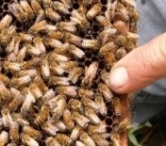FARGO – Since about 2006, experts from across the country have worked on answering a major question for American agriculture: What is killing America’s honeybees?
Today, the question remains largely unanswered, although it is beginning to look like there is no single cause, said Jim Gray, director of the pesticide and fertilizer division of the North Dakota Department of Agriculture.
Speaking Tuesday on the first day of the two-day Northern Ag Expo at the Fargodome, Gray said that about seven years ago U.S. beekeepers began to notice a disturbing phenomenon.
“The worker bees go out and they don’t come back.
“The queens are still in the hives, but the worker bees just disappear,” Gray said.
He said researchers and officials who have been exploring what is known as “colony collapse disorder” believe the estimated 30 percent decline in bee numbers is due to a number of factors.
Gray said those factors may include: pests, parasites and disease; fewer foraging opportunities; lack of genetic diversity; and pesticides.
The role pesticides may play in the drop in bee numbers has not been defined, Gray said, but a special committee formed by the U.S. Department of Agriculture to explore the issue has issued a report that includes suggestions for minimizing the harm pesticides can do to bees.
He said the suggestions focus largely on improving communication between beekeepers, agricultural producers and pesticide applicators.
For example, Gray said, beekeepers should keep landowners informed about where hives are located, and they should make sure hives are painted white or otherwise made highly visible to aerial sprayers.
He said producers and pesticide applicators should do their best to alert beekeepers when pesticides will be applied, and when possible, they should apply chemicals during times when bees are least active.
He said farmers can also support bees by establishing patches of flowering plants to give the insects places to forage.
“A little bit of flowering material goes a long way,” said Gray, who added that the half-million beehives in North Dakota make the state the biggest producer of honey in the country.
In addition to the honey and beeswax they produce, Gray said the insects are important because about a third of the country’s food supply comes from plants that depend on bees for pollination.
Dave Breker, a farmer from Lidgerwood, said he has not had much contact in the past with beekeepers operating near his farm.
But after attending Gray’s lecture on Tuesday, he intends to start, he said.
Gray said improved communication between beekeepers, landowners and those who apply chemicals to crops may not resolve every issue bee colonies face, but it would be a big step in the right direction.
“I’m convinced we’re going to find a solution,” he said.
Honeybee facts
North Dakota is the leading honey-producing state in the country, delivering more than
34 million pounds a year worth more than $65 million.
Here are additional bee facts:
• In all, the United States produces about 150 million pounds of honey a year, valued at about $286 million.
• About 90 crops in the U.S. depend on bees for pollination, with about a third of the country’s food supply dependent on bees for pollination.
• Crops that rely on bees for pollination include almonds,
as well as fruits and vegetables.
Related articles
- Honeybees suffer massive losses (adoptahive.wordpress.com)
- Clermont’s Belle Hemesath crowned Iowa Honey Queen (adoptahive.wordpress.com)











